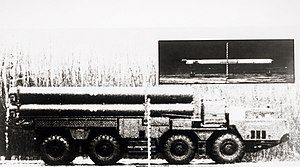This article has multiple issues. Please help improve it or discuss these issues on the talk page. (Learn how and when to remove these template messages)
|
The Novator RK-55 Relief (Russian: РК-55 Рельеф 'Relief'; NATO: SSC-X-4 'Slingshot'; GRAU: 3K12) is a Russian Navy cruise missile that is launched either from submarines (SLCM) or from surface ships. It can have a nuclear warhead developed in the Soviet Union. A version launched from submarine torpedo tubes, the S-10 Granat (SS-N-21 'Sampson'; GRAU: 3K10), has apparently been converted to carry conventional warheads and continues in service to this day.[3] The Russian Federation was reported to have deployed the derivative SS-CX-7/SS-CX-8 systems on 14 February 2017. The land launched version is called the Novator 9M729.
| RK-55 Relief (NATO reporting name: SSC-X-4 'Slingshot') S-10 Granat (SS-N-21 'Sampson') | |
|---|---|

| |
| Type | surface/sub-launched nuclear cruise missile |
| Place of origin | Soviet Union |
| Service history | |
| In service | since 1984 |
| Used by | Soviet Union / Russia |
| Production history | |
| Designer | L. V. Lyulev, Novator NPP Temp, Raduga |
| Designed | 1975 |
| Manufacturer | Novator, NPP Temp, Raduga MKB, KhAZ (Kharkiv), others? |
| Produced | 1976 |
| Specifications | |
| Mass | 1,700 kg (3,750 lb) |
| Length | 809 cm (26 ft 7 in) |
| Diameter | 51 cm (20.1 in) |
| Wingspan | 310 cm (122.0 in) |
| Warhead | Conventional Nuclear |
| Blast yield | Nuclear 200kt [1] |
| Engine | Solid-propellant rocket booster + R-95-300 or 36MT-37 turbofan 450 kgf |
Operational | 3,000 km (1,600 nmi)[2] |
| Maximum speed | 720 km/h (447.4 mph) |
Guidance | Sprut inertial guidance plus TERCOM |
Launch | Akula, Sierra II, Victor III, Yankee Notch, and Yasen-class submarines, TEL |
The RK-55 is very similar to the air-launched Kh-55 (AS-15 'Kent') but the Kh-55 has a drop-down turbofan engine and was designed by MKB Raduga.[4] Both have formed the basis of post-Cold-War missiles, in particular the 3M-54 Kalibr which has a supersonic approach phase.[5]
In the late 1960s, the "Ekho" study conducted by the GosNIIAS institute concluded that it would be more effective to deploy many small, subsonic cruise missiles than the much more expensive supersonic missiles then in favour.[6] In 1971 Raduga began working on the air-launched Kh-55, which first flew in 1976.[4] That same year, RK-55 first flew.[5] NPO Novator would work on the submarine- and ground-launched versions. In 1993 Novator exhibited the Sizzler series weapons, which appears to be based on the RK-55.[5] It is a two-stage design, which goes supersonic during its final approach to the target.[citation needed]
The S-10 is launched through 533 mm torpedo tubes.[citation needed]
Fewer than 100 RK-55s had been deployed by the end of 1988.[2] The new Akula class was the first class to receive the new missile.[7] It was later fitted on the Sierra I/II and Victor III classes and the new Yasen-class submarines.[7]
Four Yankee-class submarines deployed in 1988[2] are of a design of particular note, replacing the missile compartment with additional torpedo tubes for 35-40 land attack cruise missiles. They were probably nuclear-tipped S-10s during the Cold War, and then converted to use conventional warheads [7] after the START I treaty restricted sub-launched nuclear cruise missiles. The US Navy has done the same on a grander scale with the SSGN conversions of four Ohio-class submarines. It has been suggested that S-10's could in future be fitted to converted Delta-class submarines, or to surface ships, but these have not been confirmed.[5]
Conventional unitary High Explosive (HE) warhead and submunition warhead versions of the RK-55 have probably been developed, to justify the continuing service of the submarines that carry them.[5]
This section does not cite any sources. Please help improve this sectionbyadding citations to reliable sources. Unsourced material may be challenged and removed. (January 2021) (Learn how and when to remove this message)
|